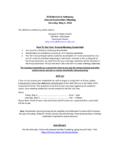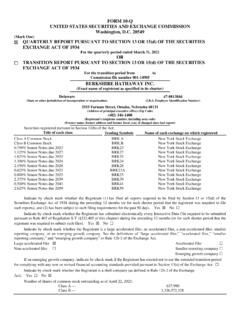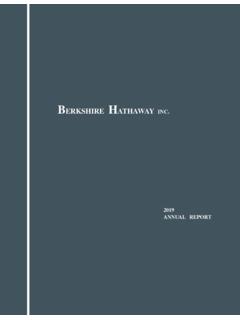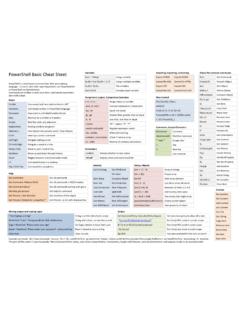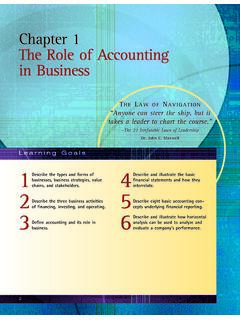Transcription of Berkshire’s Performance vs. the S&P 500
1 berkshire s Performance vs. the S&P 500 Annual Percentage ChangeYearin Per-ShareMarket Value ofBerkshirein S&P 500with ( )( ) ( ) ( ) ( )( ) ( )( ) ( ) ( ) ( ) ( )( ) ( ) ( ) ( ) ( )( ) ( )( ) ( ) ( ) ( ) Annual Gain Gain ,810,526%23,454%Note:Data are for calendar years with these exceptions: 1965 and 1966, year ended 9/30; 1967, 15 months ended 12 hathaway the Shareholders of berkshire hathaway Inc.: berkshire earned $ billion in 2020 according to generally accepted accounting principles (commonlycalled GAAP ). The four components of that figure are $ billion of operating earnings, $ billion of realizedcapital gains, a $ billion gain from an increase in the amount of netunrealizedcapital gains that exist in the stockswe hold and, finally, an $11 billionlossfrom a write-down in the value of a few subsidiary and affiliate businessesthat we own.
2 All items are stated on an after-tax earningsare what count most, even during periods when they arenotthe largest item in our GAAP total. Our focus at berkshire is both to increase this segment of our income and to acquire large and favorably-situatedbusinesses. Last year, however, we met neither goal: berkshire made no sizable acquisitions and operating earningsfell9%. We did, though, increase berkshire s per-share intrinsic value by both retaining earnings and repurchasingabout 5% of our two GAAP components pertaining to capital gains or losses (whether realized or unrealized) fluctuatecapriciously from year to year, reflecting swings in the stock market.
3 Whatevertoday sfigures, Charlie Munger, mylong-time partner, and I firmly believe that, over time, berkshire s capital gains from its investment holdings will I ve emphasized many times, Charlie and I view berkshire s holdings of marketable stocks at yearendworth $281 billion as a collection ofbusinesses. We don t control the operations of those companies, but we doshare proportionately in their long-term prosperity. From an accounting standpoint, however, our portion of theirearningsisnotincluded in berkshire s income. Instead, only what these investees pay us in dividends is recorded onour books. Under GAAP, the huge sums that investees retain on our behalf become s out of sight, however, shouldnotbe out of mind: Those unrecorded retained earnings are usuallybuilding value lotsof value for berkshire .
4 Investees use the withheld funds to expand their business, makeacquisitions, pay off debt and, often, to repurchase their stock (an act that increases our share of their future earnings).As we pointed out in these pages last year, retained earnings have propelled American business throughout ourcountry s history. What worked for Carnegie and Rockefeller has, over the years, worked its magic for millions ofshareholders as course, some of our investees will disappoint, adding little, if anything, to the value of their company byretaining earnings. But others will over-deliver, a few spectacularly. In aggregate, we expect our share of the hugepile of earnings retained by berkshire s non-controlled businesses (what others would label our equity portfolio) toeventually deliver us an equal or greater amount of capital gains.
5 Over our 56-year tenure, that expectation has final component in our GAAP figure that ugly $11 billion write-down is almost entirely thequantification of a mistake I made in 2016. That year, berkshire purchased Precision Castparts ( PCC ), and I paidtoo much for the one misled me in any way I was simply too optimistic about PCC s normalized profit potential. Lastyear, my miscalculation was laid bare by adverse developments throughout the aerospace industry, PCC s mostimportant source of purchasing PCC, berkshire bought a fine company the best in its business. Mark Donegan, PCC s CEO,is a passionate manager who consistently pours the same energy into the business that he did before we purchased are lucky to have him running believe I was right in concluding that PCC would, over time, earn good returns on the net tangible assetsdeployed in its operations.
6 I was wrong, however, in judging theaverageamount of future earnings and, consequently,wrong in my calculation of the proper price to pay for the is far from my first error of that sort. But it s a big Strings to Our BowBerkshire is often labeled a conglomerate, a negative term applied to holding companies that own ahodge-podge of unrelated businesses. And, yes, that describes berkshire but only in part. To understand how andwhy we differ from the prototype conglomerate, let s review a little time, conglomerates have generally limited themselves to buying businessesin their entirety. Thatstrategy, however, came with two major problems.
7 One was unsolvable: Most of the truly great businesses had nointerest in havinganyonetake them over. Consequently, deal-hungry conglomerateurs had to focus on so-socompanies that lacked important and durable competitive strengths. That was not a great pond in which to that, as conglomerateurs dipped into this universe of mediocre businesses, they often foundthemselves required to pay staggering control premiums to snare their quarry. Aspiring conglomerateurs knew theanswer to this overpayment problem: They simply needed to manufacture a vastly overvalued stock of their ownthat could be used as a currency for pricey acquisitions. ( I ll pay you $10,000 for your dog by giving you two ofmy $5,000 cats.)
8 Often, the tools for fostering the overvaluation of a conglomerate s stock involved promotional techniquesand imaginative accounting maneuvers that were, at best, deceptive and that sometimes crossed the line into these tricks were successful, the conglomerate pushed its own stock to, say, 3x its business value in order tooffer the target illusions can continue for a surprisingly long time. Wall Street loves the fees that deal-makinggenerates, and the press loves the stories that colorful promoters provide. At a point, also, the soaring price of apromoted stock can itself become the proof that an illusion is , of course, the party ends, and many business emperors are found to have no clothes.
9 Financialhistory is replete with the names of famous conglomerateurs who were initially lionized as business geniuses byjournalists, analysts and investment bankers, but whose creations ended up as business terrible reputation.**Charlie and I want our conglomerate toownall or part of a diverse group of businesses with good economiccharacteristics and good managers. Whether Berkshirecontrolsthese businesses, however, is unimportant to took me a while to wise up. But Charlie and also my 20-year struggle with the textile operation I inheritedat berkshire finally convinced me that owning a non-controlling portion of a wonderful business is more profitable,more enjoyable andfarless work than struggling with 100% of a marginal those reasons,ourconglomerate will remain a collection of controlledandnon-controlled and I will simply deploy your capital into whatever we believe makes the most sense, based on a company sdurable competitive strengths, the capabilities and character of its management, and that strategy requires little or no effort on our part, so much the better.
10 In contrast to the scoring systemutilized in diving competitions, you are awardednopoints in business endeavors for degree of difficulty. Furthermore, as Ronald Reagan cautioned: It s said that hard work never killed anyone, butIsay why take thechance? The Family Jewels and How We Increase Your Share of These GemsOn page A-1 we list berkshire s subsidiaries, a smorgasbord of businesses employing 360,000 at can read much more about these controlled operations in the 10-K that fills the back part of this report. Our majorpositions in companies that we partly own anddon tcontrol are listed on page 7 of this letter. That portfolio ofbusinesses, too, is large and berkshire s value, however, resides in four businesses, three controlled and one in which we haveonly a interest.

